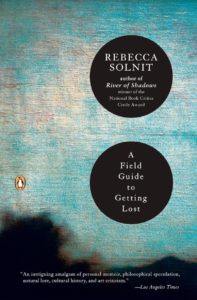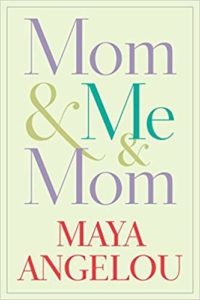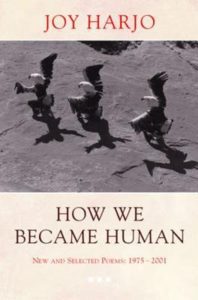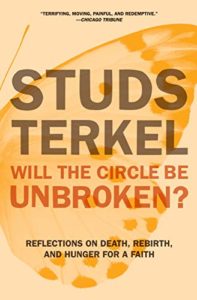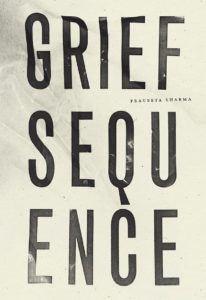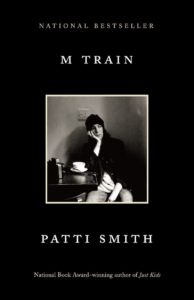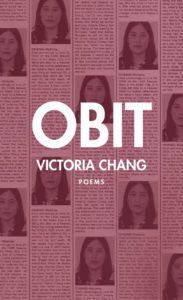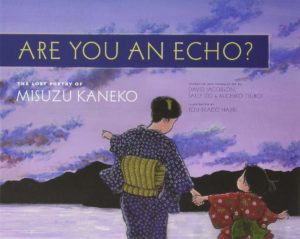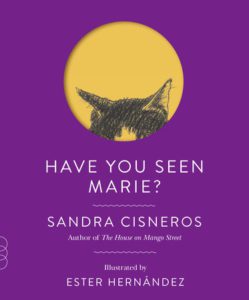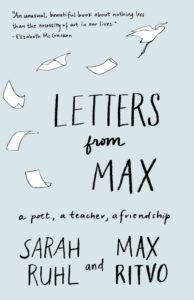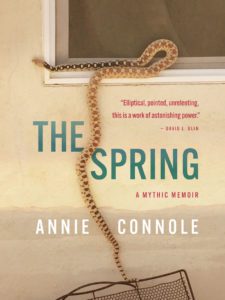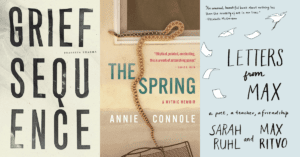
If you are reading this, you are among the living. As we emerge from a year that so many others did not survive, what can we read to be with grief, the powerful and profound visitor of the living?
When I lost my partner nearly seven summers ago, I remember lying on a borrowed couch and being hungry for beauty, wanting desperately to hold it in my mind, because beauty was a wrecking ball. I found it most reliably in poems. “I go to them in the middle of the night when there are no other answers,” I wrote to a friend. Poetry was shelter.
In those first weeks, I was grateful for having read Joan Didion’s The Year of Magical Thinking and Blue Nights years earlier, for all the books I’d ever read, really, even for having played Hamlet’s mother in a summer theater production when I was ten—the memory of a scream and the knowledge that the scene changes, another Act eventually follows. Didion’s stories were helpful, but by the time I was in the roar of my own grief, I couldn’t hold the details of someone else’s catastrophic loss. So, I gravitated towards books that dealt more overtly in symbolism, metaphor, abstraction—they provided a bridge over and through.
Helene Cixous said, “Writing is learning to die. It’s learning not to be afraid, in other words, to live at the extremity of life, which is what the dead, death, give us.” The books that follow, I believe, can help us know how to live at the edge, ask questions with no answers, to sing or wail wildly into the mystery of death.
***
A Field Guide to Getting Lost by Rebecca Solnit
The world as I knew it before July 13 was gone. I knew I was in another country, which, by that time, was my sister’s childhood basement bedroom. The decay was underway and becoming more deeply and physically lost seemed necessary for survival. I found Solnit’s A Field Guide to Getting Lost at this time and burrowed into its pages through a dark October. Her reflections on the necessity of getting lost in order to be found and the relationship between decay and transformation were exactly what I needed. She conveys stories of captives who changed so dramatically that they had no desire to return and of butterflies emerging miraculously from chrysalises. She writes, “You have to die a little to be reborn, and death comes first, the death of a story, a familiar version of yourself.” By the time I finished reading it along with its sister book, The Nearby Faraway, I found the courage and vision to get lost, to put my finger on a map, and drive to a desert with the hope that I would one day be found.
Mom & Me & Mom by Maya Angelou
Before heading south to the desert, I stopped at the library, borrowed the audiobook of Maya Angelou’s Mom & Me & Mom, and listened to it the entire way down. In the years before this trip into the unknown, I read through Angelou’s autobiographies and held them close—exemplary stories of how to become, how to live many lives in one, how to encounter and transcend the hands you are dealt. As I drove into the night through the vast open miles of southern Utah, my car filled will Angelou’s recounting of the terrifying night she was beat up and nearly died at the hands of a former boyfriend. Her vulnerability was crushing. She prays of being saved and is found by her mother. The stories in this book tell of love’s role in healing and reinvention, as we see how Maya’s mother, with her strong vision and guidance, help Angelou rise from depression, from the end of a marriage, as she continues to reinvent herself and step forward into her own power. Grief can be lonely and isolating, but Angelou reminds us, “Love heals. Heals and liberates.” Her stories of love and care were a light beam carrying me another mile in the dark.
How We Became Human: New and Selected Poems: 1975-2001 by Joy Harjo
On a foggy, confused day in the aftermath of loss, I was drawn to this collection in a bookstore by its title: How We Became Human—because grief is a process of becoming more human. Harjo knows that survival is the twin of grief and her poems transmit the beautiful ache of living. For her, the ache is personal and collective, it is for her people and the earth. The last poem in the collection, “When the World as We Knew It Ended,” reflects on a way of life coming to an end on September 11, but also how the pulse of living beckons and continues on even after the towers collapse. The poem speaks to this season’s truth as we emerge from the tragedy of our pandemic year, including the second-to-last stanza:
But then there were the seeds to plant and the babies
who needed milk and comforting, and someone
picked up a guitar or ukulele from the rubble
and began to sing about the light flutter
the kick beneath the skin of the earth
we felt there, beneath us
Will the Circle Be Unbroken?: Reflections on Death, Rebirth and Hunger for a Faith by Studs Terkel
This book has been by my bedside this entire pandemic year. In grief, we become intimate with death, its contours. There are so many questions. It is another country and Terkel ushers us into it. Questions on the nature of death and the other side are asked by the many voices in this oral history of everyday people mostly living in Chicago at the end of the last century. They are voices of a woman who was a housekeeper at the Cook County Hospital AIDS ward, a cemetery familiar, a lover, a brother, a politician and writer from the Pine Ridge Reservation, a woman who spent years in a coma—all of them speaking eloquently and earnestly about their lived experiences beside death. A sweet vulnerability shines through. You feel like you dropped in on each person having coffee in their home, the page a window into their hearts and the room where so much has happened.
Grief Sequence by Prageeta Sharma
As a friend, I knew pieces of Sharma’s grief story, which unfolded somewhat concurrent to my own. But when I took home a copy of Grief Sequence after a celebration of the book one lovely November day in Pomona, I became dazzled, entranced, taken. Sharma’s sequence of poems deftly elucidate the multiple concurrent emotions, narratives, and life paths that flow into one great river in times of collapse and rebirth. She writes of the terror of watching a partner being swiftly taken by the ravages of cancer, absence and presence in death’s aftermath, and of unexpectedly encountering new love with a widower generous of heart. In the poem, “MARCH WIND,” Sharma writes, “I learn that there are two winters and two early springs happening at the same time and I have to turn one season to the other to get past their painful awakenings.”
M Train by Patti Smith
Maybe, like me, you’ve already cried through three Kleenex boxes reading Smith’s Just Kids. It floored me, and yet M Train is the book that I continue to revisit again and again. M Train is elegy, too, but with a wider lens, creating a topography of reverie and longing—for an old coat, a toy named Reddy, the walking stick of Virginia Woolf, her late husband Fred and brother Todd, the open arms of childhood. By the end, all the longing coalesces into a moral vision for how to live, to be present, “even as the ghosts attempt to draw us away.” In recognizing the fleetingness of all things, she also distinguishes the value of living one’s life fully, which exists moment to moment, and will someday be retrieved only in the memory of those who survive us. Smith writes, “I believe in movement. I believe in that lighthearted balloon, the world. I believe in midnight and the hour of noon… I believe in life, which one day each of us shall lose.”
Obit by Victoria Chang
I held the pages of this book tightly in the dim nights just before and after receiving the vaccine. Chang met me at the crossroads. Obit marks the continual coming apart and putting back together that is a parent with dementia, that is a parent with brain damage from a stroke, that is the ongoing change/loss before and after a parent’s death. In fluid prose that unravels her days, Chang pens small obits announcing the death of Language, Empathy, Logic, America, Memory, Optimism, Guilt, The Future, Oxygen, etc.—everything that fractures and breaks off in grief, yet remains significant. In an obit for Memory, she writes, “Death was still abstract, it could slip down the drain. Sadness was still indivisible. In twenty-three days, it would detonate and shower us like confetti. The water flattened my mother’s hair and began burying her tongue.”
Are You an Echo?: The Lost Poetry of Misuzu Kaneko by Misuzu Kaneko; translated by David Jacobson, Sally Ito, and Michiko Tsuboi; illustrated by Toshikado Hajiri
This illustrated book contains both the poetry and life story of celebrated writer Miuzu Kaneko, who was born in Japan in 1903 and ended her own life at the age of twenty-six. One of the things I loved about the book was how the story eschewed the shame often associated with suicide, going on to show how Kaneko’s work continues to “echo” as poems read in schools in Japan and broadcast on television after the 2011 tsunami. The poems featured in the book are about looking closely and having empathy with the flower, the telephone pole, the weeping whale child. They honor impermanence. In “Cocoon and Grave” Kaneko offers a way to see her impending transformation: “A person enters a grave— / that dark, lonely grave. // But the good person / will grow wings, become an angel / and fly away.”
Have You Seen Marie? by Sandra Cisneros, illustrated by Ester Hernández
Arrive in San Antonio with Sandra Cisneros, newly orphaned at fifty-three. Be carried by her through the streets of San Antonio in a search of a friend’s cat. See the commonplace of grief in her neighbors’ faded blue eyes, tattooed tears, and loss of hearing. At the end of the day’s search, Cisneros calls out not for the cat, but for her mother, feeling her spirit in the wind, stars, trees and clouds saying, “Here I am, mija.” To bookend this story of seeking, Cisneros includes an eloquent Afterward: “I wish somebody had told me to draw near me objects of pure spirit when living between births. My dogs. The trees along the San Antonio River. The sky and clouds reflected in its water. Wind with its scent of spring.”
Letters from Max: A Book of Friendship by Sarah Ruhl and Max Ritvo
To read this book is to enter into the joy of epistolary correspondence—the spark and delight of true, devoted friendship, as well as the buoyancy of treating each day, each word as singular and holy. The four-year correspondence between Ruhl and the late Ritvo, as documented in this book, is a true dialectic. The tone is effusive, electric, and contagious even in the face of death, even when Ritvo is writing between chemo sessions, even after he has left his body and Ruhl continues her letters, revealing the tenuous and heartbreaking search for the beloved after the curtain falls. Not finding Ritvo at his old address (his earthly body), Ruhl’s last letter summoned my own tears: “Your new address: Love?—unknown by postal service—God Something Something, Air Something Lane or Terrace, and me impersonating your voice—does it live here still? Come back, come back, come back.”
And to close out this wonderful list, we just had to include Annie’s debut memoir, The Spring, out now from Chin Music Press! – Ed.
The Spring: A Mythic Memoir by Annie Connole
Traversing the wild landscapes of the American West, prose and photography combine to create a lucid, dream-like vision of visitations and allegorical animal encounters with Snake, Owl, and Dragonfly, among others. The Spring tells a stirring, elegiac tale of death, love, rebirth, and transformation.

